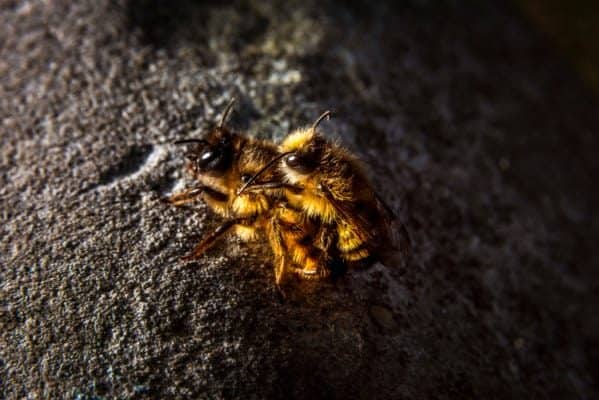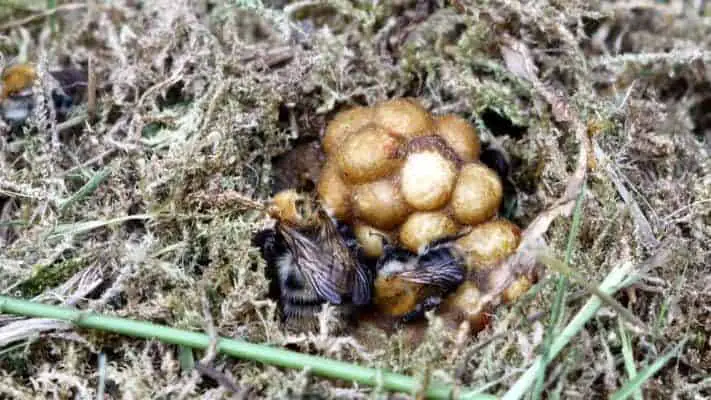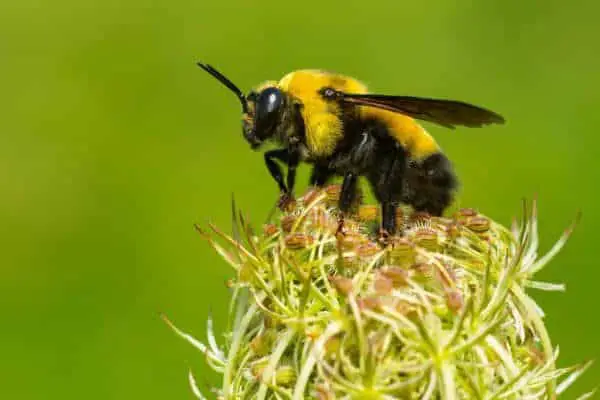
Many people don’t go a day outside without seeing a bumblebee buzzing about in the grass. Bees are essential in nature to pollinate plants and flowers. A good amount of our fruits and vegetables are a result of bees pollinating the crops. However, we never seem to see bumblebees flying around at night. Why is that?
Where do bumblebees go at night? Solitary bumblebees rest inside their nectar sources in the middle of flowers protecting them from the elements. Social bumblebees typically stay in their nest, with the queen bee. The nest keeps their colony warm and dry through the night and provides a safe spot for nectar stores and brood.

What also contributes to the lack of activity bumblebees at night is their napping and motion patterns. We’ll explain in this article what bumblebees do at night, where they commonly live, and exactly what bumblebees do in the winter to prepare for the spring, the most active time for bumblebees.
Are Bumblebees Active At Night?
Many people don’t see bumblebees after dark, so they assume that bumblebees aren’t active at night. However, they do fly around during the evening on occasion. The most active months for bumblebees are between March and October, but some stick around all year in southern climates. The biggest bumblebee colonies exist during the middle of the summer until early fall due to warmer weather.
People can spot bumblebees flying during daylight hours since they tend to prefer ideal temperatures in the spring. However, they will nap more often during the day when it’s summertime because of the hotter temperatures. They’ll wait and take advantage of the cooler temperatures of the early morning or the evening to pollinate. It’s easiest to spot them on flowers that they’re pollinating.
In the spring and summer, it is not uncommon to see bumblebees and honey bees at night surrounding lights in and around your house. Bees, like moths, are attracted to light.
Sadly, if you spot bumblebees, or another sort of bee, hovering around your home at night, most likely the bee is not going to survive. The bees’ unwavering attraction to the light will see them quickly run out of energy as flight burns through the nectar they have in their stomachs. Even if you turn the lights off they will not make it home as they use the sun for navigation.
There is another potential reason that these bees could be dead in the morning according to Home Steady, “If bees fly around your porch lights at night and you notice several dead bees nearby the next day, they are likely honeybees or bumblebees that were parasitized by the Apocephalus Borealis fly.”
The flies lay their eggs on the bees, then begin to eat the bee alive as soon as the eggs are hatched into the form of maggots. This phenomenon causes the bees to buzz around porch lights at night, leaving their colonies, and die the next day.
Parasitic flies are known to be the biggest threat to bumblebees as a species. They can cause catastrophic endangerment to the humble bumblebee which in turn affects pollinating flowers and crops in agriculture.
What Bumblebees Do At Night
Apart from needing time to rest there are two good reasons why bumble bees do not fly at night.
1. Temperature
The reason why bumblebees can’t fly at night usually is because bees require an optimum temperature of 50 degrees Fahrenheit (10 degrees Celsius). Temperatures below put the bees at risk of dying if they fly outside. With the night comes cooler temperatures and the bees know to shelter from this.
2. Navigation
Bees are experts at navigation seeking out flowers spending their day foraging before returning to their colony. They use the sun to navigate, the bees have the ability to use polarized light to navigate. This unique ability even works on cloudy days as polarized light penetrates clouds. At night in the absence of the sun, they are unable to navigate effectively.
Social bumblebees workers return to the nest at night to rest from the days foraging. They also help keep the nest warm during the cool of the night.
Male solitary bumblebees, who leave their nest only days after emergence, will find refuge at night in flowers or under the shelter of stems or leaves. Once they have found their resting place for the night, they remain motionless to rest and re-energize for the next day.
Female solitary bumblebees live underground or in cracks or crevices in walls or trees. They return to these nests at night for recovery and shelter from the elements.
What Do Bumblebees Do While Resting?
The queen and most worker bumblebees will rest in the nest particularly at night or during bad weather. Through winter and early spring depending on the outside temperature the new queens will hibernate in the ground resting, quietly waiting for the spring to bring on warmer temperatures and flowers loaded with pollen and nectar.
During the summer it is not uncommon to find male bumblebees resting outside as they leave their colonies, never to return, a few days after emerging from their brood cell.

The bees will sleep outside of the nest and rest where it’s warmer in temperature. According to Tenth Acre Farm, bees will sleep under a flowerhead or inside a deep flower like a squash blossom where the temperature can be up to 18 degrees warmer close to the nectar source.
How Long Do Bumblebees Live For?
For worker bumble bees life is pretty short. They have a hard life foraging for nectar and pollen to help support their queen and colony.
According to a research article published by The Canadian Journal of Zoology, their adult life can be as short as three weeks if nectar and pollen are in short supply.
With limited availability of pollen and nectar, the worker bee is forced to fly longer distances. This not only wears out their wing structure quicker it also exposes them to the risk of running out of energy, causing them to essentially die of starvation. No worker bees live through the winter.
The queen bumblebee lives for about a year. She begins life in late summer when she will look to mate with drone (male) bees in the fall before leaving their colony to seek a location to hibernate throughout the winter.
As the spring warmth begins the queen emerges from hibernation and starts working immediately, searching for a suitable location of a new nest. She will work hard to begin building her nest, storing supplies of pollen and nectar ready to lay her first batch of eggs.
The first round of eggs will eventually develop into worker bees who from then on will supply the colony with nectar and pollen. They also have the responsibility of looking after the housekeeping duties in the nest. The queen can then focus on laying more eggs to grow the number of bees in her hive.
In the late summer, the queen will die and numbers in the colony will also decrease with the new virgin queens left to carry on for the next year.
The Wrap Up
Bumblebees aren’t active at night, at least they are not intending to be active. Bees that may be returning to the colonies late in the day around dusk are unfortunately attracted to artificial light, like those around your house. This light is distracting and the bees easily become disorientated.
The lost bees inevitably die, either just running out of energy to fly or in some cases they are taken over by parasitic flies that eat the bee alive.
Male bumblebees rest in flowers at night in an attempt to stay as warm as possible. They’ll position themselves near the nectar source of the flower and in the warmth of the day, will seek out virgin queens to mate with.
You’ll tend to see bumblebees between the spring and the fall, as only the queen bees survive the winter by hibernating in the ground. Queen bees live for about a year beginning life in the late summer, while worker bees and some male bees only live for a few weeks.
References:
https://cals.arizona.edu/pubs/insects/ahb/inf21.html
https://www.researchgate.net/publication/238010567_Adult_longevity_of_workers_of_the_bumble_bees_Bombus_fervidus_F_and_Bombus_pennsylvanicus_De_Geer_Hymenoptera_Apidae
